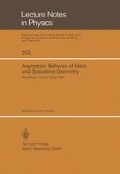Preview
Unable to display preview. Download preview PDF.
References
For a more detailed review of these results see Y. Choquet-Bruhat, “Positive Energy Theorems”, 1983 Les Houches Lectures.
G. Abbott, S. Deser, Nucl. Phys. B195, 76 (1982).
P. Breitenlohner, D. Freedman, Phys. Lett. 115B, 197 (1982); Ann. Phys. 144, 249 (1982).
G. Gibbons, C. Hull, N. Warner, Nucl. Phys. B218, 173 (1983).
G. Gibbons, S. Hawking, G. Horowitz, M. Perry, Commun. Math. Phys. 88, 295 (1983).
For alternative definitions of asymptotic flatness at spatial infinity see R. Geroch in Asymptotic Structure of Space-Time, Eds. F. Esposito and L. Witten, Plenum, New York (1977); and A. Ashtekar in General Relativity and Gravitation, Vol. 2, Ed. A. Held, Plenum, New York (1980).
R. Arnowitt, S. Deser, C. Misner, Phys. Rev. 122, 997 (1961).
J. Nester, Phys. Lett. 83A, 241 (1981).
This can perhaps be improved by imposing an additional condition on ξa. If ξa is chosen to be a timelike Killing field, then replacing Fab with wab just yields Komar's formula for the total energy. (A. Komar, Phys. Rev. 113, 934 (1959).)
We adopt the notation and sign conventions of F. Pirani in Lectures on General Relativity Brandeis Summer Institute in Theoretical Physics, Prentice Hall, New Jersey (1965). Thus the metric has signature (+—) and the curvature tensors are defined by \(2\nabla _{[a} \nabla _{b]} \xi _c = - R_{abc} ^d \xi _d ,R_{ab} = R_{amb} ^m .\)
If one considers a pair of two component spinors, i.e. a Dirac spinor, then one can discuss changes in orientation. However, in this case the spinors change sign as well as the εabcd, so the total four momentum is invariant.
S. Hawking and G. Ellis, The Large Scale Structure of Space-Time Cambridge University Press, Cambridge (1973).
H. Araki, Ann. Phys. 7, 456 (1959).
D. Brill, Ann. Phys. 7, 466 (1959).
D. Brill, P. Jang in General Relativity and Gravitation Vol. 1, Ed. A. Hled, Plenum, New York (1980).
J. York, in Essays in General Relativity ed. F. Tipler Academic Press, New York (1980).
R. Schoen, S.-T. Yau, Commun. Math. Phys. 65, 45 (1979); Phys. Rev. Lett. 43, 1457 (1979); Commun. Math. Phys. 79,47 (1981); 79, 231 (1981). The first paper gives the proof assuming there is a maximal surface. The second outlines the general proof. The third weakens the boundary conditions required at infinity, and the fourth gives further details.
S. Hawking, R. Penrose, Proc. Roy. Soc. Lond. A314, 529 (1970). The similarity between the proof of the singular ty theorem and Schoen and Yau's proof of the positive energy theorem was pointed out in reference (15).
E. Witten, Commun. Math. Phys. 80, 381 (1981).
G. Horowitz, M. Perry, Phys. Rev. Lett. 48, 371 (1982).
T. Parker, C. Taubes, Commun. Math Phys. 84, 223 (1982).
O. Reula, J. Math. Phys. 23, 810 (1982).
C. Teitelboim, Phys. Lett. 69B, 240 (1977); S. Deser, C. Teitelboim, Phys. Rev. Lett. 39, 249 (1977).
M. Grisaru, Phys. Lett.73B, 207 (1978).
G. Horowitz, A. Strominger, Phys. Rev. D27, 2793 (1983).
S. Deser, Phys. Rev. D27, 2805 (1983).
C.M. Hull, Commun. Math. Phys. 90, 545 (1983).
For a precise definition of asymptotic flatness at null infinity see R. Penrose, Proc. Roy. Soc. Lond. A284, 159 (1965) and Reference (5).
H. Bondi, M. Van der Burg, A. Metzner, Proc. Roy. Soc. Lond. A269, 21 (1962); R. Sachs, Proc. Roy. Soc. Lond. A270, 103 (1962); Phys. Rev. 128, 2851 (1962).
R. Geroch, J. Winicour, J. Math. Phys. 22, 803 (1981).
J. Nester, W. Israel, Phys. Lett. 85A, 259 (1981).
Although Eq. (20) looks identical toy (6) there is a slight difference. On an asymptotically flat surface, dgα A is defined to be a spinor satisfying ∂m °α A = 0 where ∂m is the derivative operator of the flat metric that the physical metric approaches. On an asymptotic null cone one does not have a flat three metric. Instead one defines °α A to a spinor whose components in the standard spinor basis are just spin ½ spherical harmonics.
A. Ashtekar, A. Magnon-Ashtekar, Phys. Rev. Lett. 43, 181 (1979).
For a detailed review of this result see M. Walker in Gravitational Radiation, Eds. N. Deruelle and T. Piran, North Holland (1983).
R. Schoen and S.-T. Yau, Phys. Rev. Lett. 48, 369 (1982).
M. Ludvigsen, J. Vickers, J. Phys. A15, L67 (1982).
O. Reula, P. Tod, “Positivity of the Bondi Energy,” Oxford University Preprint (1983).
A different boundary condition which also yields a positive surface integral is discussed in M. Ludvigsen, J. Vickers, “Trapped Surfaces and the Positivity of the Bondi Mass,” University of Canterbury preprint (1982).
A. Ashtekar, G. Horowitz, Phys. Lett. 89A, 181 (1982).
G. Gibbons, C. Hull, Phys. Lett. 109B, 190 (1982).
P. Tod, Phys. Lett. 121B, 241 (1983). This paper also discusses plane wave spacetimes which are not asymptotically flat.
O. Moreschi, G. Sparling, “Positive Energy Theorem in Kaluza-Klein Theory” in 5 Dimensions and a New Theorem in 4 Dimensions: University of Pittsburgh, preprint (1983).
R. Penrose, Ann. N.Y. Acad. Sci. 224, 125 (1973).
P. Jang, R. Wald, J. Math. Phys. 18, 41, (1977).
J. Friedman, S. Mayer, J. Math. Phys. 23, 109 (1982).
R. Penrose, Rev. Nuovo Cimento 1, 252 (1969). *** DIRECT SUPPORT *** A3418159 00002
Author information
Authors and Affiliations
Editor information
Rights and permissions
Copyright information
© 1984 Springer-Verlag
About this paper
Cite this paper
Horowitz, G.T. (1984). The positive energy theorem and its extensions. In: Flaherty, F.J. (eds) Asymptotic Behavior of Mass and Spacetime Geometry. Lecture Notes in Physics, vol 202. Springer, Berlin, Heidelberg. https://doi.org/10.1007/BFb0048063
Download citation
DOI: https://doi.org/10.1007/BFb0048063
Published:
Publisher Name: Springer, Berlin, Heidelberg
Print ISBN: 978-3-540-13351-3
Online ISBN: 978-3-540-38897-5
eBook Packages: Springer Book Archive

